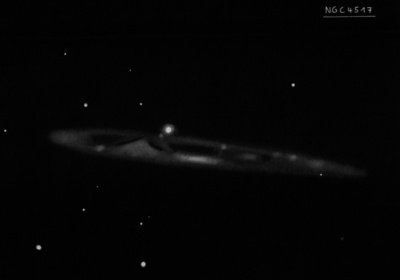
NGC 4517A, located 17' NNW, appeared very faint, large, small brighter core. Appears as a very diffuse hazy region elongated SSW-NNE with no distinct boundaries. Located 3.5' SE of a mag 10.5 star.
William Herschel discovered NGC 4517 = H IV-5 on 22 Feb 1784 (sweep 153) and recorded "A pretty bright star with a milky ray on the south side of it, extending from east to west, or rather from np to sf. It does not seem to touch the star, and is about 10 or 12' in length." On a second observation (1 Jan 1786, sweep 507), he added "a pB star with a milky ray to the south of it, and partly including it." WH commented this might suggest that the nebula had a considerable proper motion, though differences in observing conditions might account for the difference. The GC and NGC position (from 3 observations) is 0.5 min of RA too far east and 2' south.
JH found h1277 = NGC 4437 on 14 Apr 1828 and recorded "F; vmE; pos 15° nf to sp; a long ray; it is south preceding a * 10m. The place is that of the star." There is nothing near his position, but 5 min of RA east is NGC 4517 and his description is a perfect match with this galaxy. The equivalence may have first been suggest by Karl Reinmuth in his 1926 photographic Heidelberg survey "Die Herschel Nebel". Various sources (including the RNGC) mistakenly equate NGC 4437 with NGC 4417, instead of NGC 4517. So, NGC 4517 = NGC 4437.
400/500mm - 17.5" (3/24/90): moderately bright, very large edge-on 8:1 WSW-ENE, almost 10'x1.2'. This galaxy is an impressive large narrow streak with fairly low surface brightness and fills 1/2 of the 21' field. There is no well-define nucleus but central region slightly bulges. Appears brighter along the western extension. A mag 9 star is attached at the northeast edge of the core.
900/1200mm - 48" (5/4/16): beautiful edge-on spiral, nearly 8:1 WSW-ENE, ~11'x1.5'. A mag 10.9 star is attached on the north edge, just east of center. The galaxy is broadly concentrated with a larger, brighter core region and small brighter nucleus. A fairly prominent, irregular dust lane extends ~5', unevenly slicing the galaxy along the north edge of the core region. The absorption lane is widest and most prominent near the core. A fairly thin strip of the galaxy is visible to the north of the dust lane, passing through the bright star at the north edge. The dust gives the galaxy an irregular patchy appearance and along with some mottling, the view is reminiscent of NGC 253 or NGC 55.
NGC 4517A, situated 17' NNW, appeared moderately bright, large, oval 4:3 SSW-NNE, ~3'x2.2', broad concentration with a small brighter core, patchy, irregular surface brightness. A mag 10 star is 3.5' NW and a mag 11.5 star is 4.6' W.
Notes by Steve Gottlieb